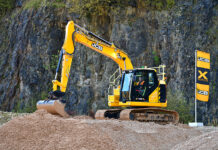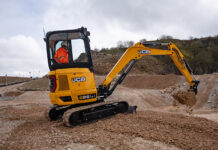
THEY say a picture is worth a thousand words. In the challenging field of construction photography, when a perfectly timed shot of a standout machine in action can take your breath away, that idiom seems particularly relevant.
It is perhaps little wonder then that David Wylie’s book, Earthmovers in Scotland, featuring over 430 pages of images and stories from some of the nation’s major mining, quarry, roads and forestry sites, has generated such interest.
David recently sold several copies of his book whilst attending ScotPlant 2018 and revealed Volume Two is a distinct possibility after receiving widespread praise for the publication.
By day, David is a part-time fleet compliance engineer who works for the Freight Transport Association (FTA), and combines his interests in machinery and photography to contribute on a freelance part-time basis to industry titles such as Earthmovers and Farm Machinery Journal. He has also been commissioned by plant manufacturers to provide photographs for the likes of brochures and in-house publications.
David, who is originally from Glasgow, traces his love of plant back to his childhood when his father Sam worked as a machine operator for Hewden Stuart Group.
His interest in photography, meanwhile, intensified in the late 1980s when he attended night classes in photography at Glasgow University.
“It started initially as a hobby,” he explained. “I actually bought Canon’s first EOS system – the EOS 600. I always had an eye for a picture. At the Freight Transport Association, I’ve occasionally assisted the sales and marketing team to write about what we do. I’ve ended up writing a few case studies about vehicle inspection service and discovered I had a bit of a knack for it.”
David continued snapping construction sites for fun until his ‘sliding doors moment’, as he calls it, occurred around ten years ago when he entered a competition run by Contract Journal around the theme of earthmoving images.
“I submitted stuff I’d taken on different sites you can view just as a member of the general public,” David said. “There was a Case machine operating at Newhouse – just a farmer digging out some soil. I asked him if I could take some pictures. To cut a long story short, I submitted it and won. The prize was a big book – 75 years of Caterpillar. I was absolutely delighted but I wrote to them and suggested that the next time they ran a photography competition, it would be great to make the prize something like a visit to take photographs of an application of that person’s choice.”
Much to David’s surprise, the publication replied and asked him where he’d like to go.
“At that time Scottish Coal was running those big Liebherr 9350 machines at Broken Cross,” he recalled. “They set it up with Scottish Coal to access this massive surface coal mine. It wasn’t part of my brief but I wrote 1000 words about my visit and ended up getting a two-pager in Contract Journal. That was my first publication.”
Since then, David’s foray into photojournalism has seen him travelling Scotland and beyond covering major projects including the Forth Replacement Crossing and the M8 M73 M74 Motorway Improvements scheme in Lanarkshire.
With a large body of work behind him, he decided to write a book featuring many of his favourite shots along with detailed reports of his various site visits over the years.
“When I go onsite, I take about 400 images,” David explained. “The magazine will maybe use 15 or 20 so I had this whole collection of images that had never been seen, including some particular favourites.
“The magazines do an amazing job of setting out my work, however this is my attempt at a director’s cut; my complete and unedited version. And where possible, there’s a lot of new information.
“One of the big things I decided to do, and I think this is a key feature of the book, is include 80 double-page images. That means 160 pages of just pictures with no text. I had to convince the publisher that this was the way to go.
“The thing I’m really proud about is that the whole concept and design is completely from me. I wrote an eight-page business case about why this book should be published.
““The response has been really good. One reader was just completely blown away with my story about Cat 785D trucks at Broken Cross and one of the photos, which has a big Terex green dump truck in the background.
“Jim Donnelly, who’s the operations director of Banks Mining, sent me a nice e-mail saying that once he opened the book, he couldn’t put it down.”
The front cover features a shot of a Cat 6030 being put to work for Banks Mining at Rusha surface mine in West Lothian. From tens of thousands of images, what prompted David to choose this for the cover?
“I really like it because it’s an action image,” he said. “The machine is immaculate. The operator had taken particular care of it; there wasn’t a scratch on it; it was a bright day; blue skies; a white machine – which is unusual for a Cat – and I’d actually taken advice from people who publish on a regular basis. They said to go for the ‘hero shot’.
“A good construction photo has got to be well composed. I don’t put my camera on motor drive and blast five or six pictures. I really pick my moment; it’s all about timing and knowing what’s coming up. It’s a bit like sports photography; you know when a goal might be getting scored because you’ve seen it umpteen times.
“With construction photography, it’s about knowing when that bucket’s going to open or a certain position you need to be in to get the shot.”
David’s book, which is written in chronological order, begins in 1994 with some shots he took from the side of the road at Northrigg Opencast site near Bathgate.
“I remember it well because at the start of the roll of film, there are pictures of my daughter when she was very young,” he explained.
“There are six images of her and the rest are of machines; she’s never let me live it down! With no access to site I shot them from about 300 yards away. I got them digitalised so they could be printed in my book. I really wanted to talk about restoration in my book so I’ve included an image of the site taken just a couple of years ago. You would never know that this had been an opencast site. The industry gets a lot of bad press that they don’t restore sites; but the good operators do.”
Other highlights include David’s trip to Glensanda in 2015, something that had been on his ‘to do’ list for some time.
“That was with the big Cat 992 wheel loading shovels,” he recalled. “That was an amazing visit because you see normal quarry operations maybe producing 6,000 tonnes per week. You go to Glensanda and those guys produce that in three hours.”
In total, David spent around six months on the book, including three to four months re-tweaking the manuscript.
“I didn’t realise how much work was involved,” he admitted. “There are 85,000 words. The hardest part was picking pictures. Then I had to decide what pictures were going where.
“I got to see it being printed in Bristol. I was on assignment in Spain and had to rearrange my flight details as I was told at short notice when it was being printed. It was a long day but really worthwhile.
“There will be a Volume Two but I need to find the time as it’s a huge amount of work.”
• Earthmovers in Scotland is published by Old Pond publishing – www.oldpond.com








